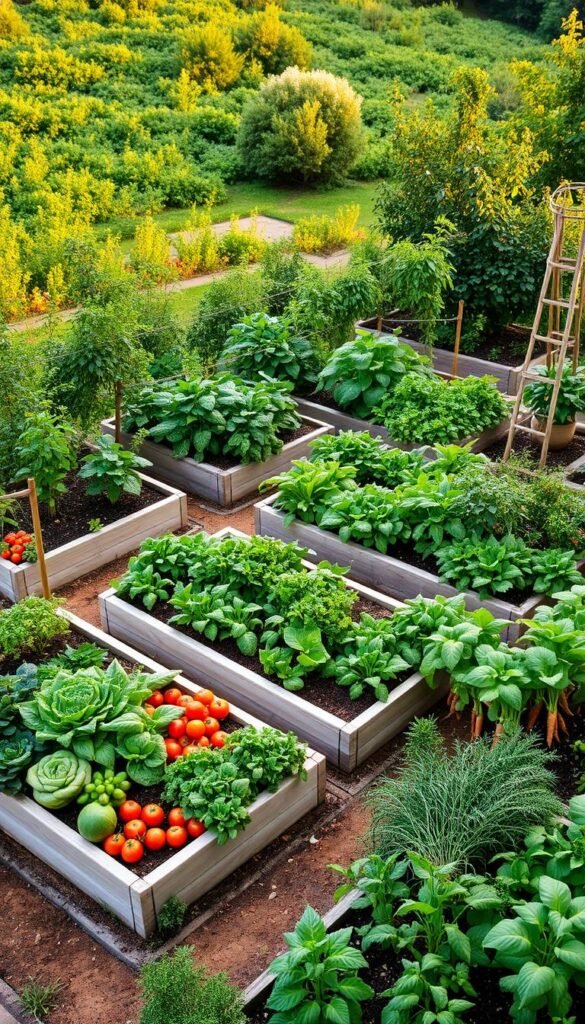What if your compact growing area could produce twice as much fresh food as you thought possible? Urban gardening expert Steven Biggs reminds us there’s no single “perfect” design—just creative solutions tailored to your unique space. Whether you’re working with raised beds, containers, or a sliver of backyard soil, strategic planning unlocks surprising potential.
Traditional row planting often wastes precious real estate. Modern approaches like block-style arrangements pack more plants into tight quarters while improving airflow. Imagine harvesting crisp lettuce between tomato vines or tucking radishes among slower-growing carrots—every inch becomes productive.
Your mindset matters as much as your measurements. Instead of focusing on limitations, discover how companion planting creates natural pest control. Basil repels aphids near tomatoes, while onions mask carrot scents from root flies. These partnerships turn constraints into clever advantages.
Success starts with smart preparation. Vertical structures and dwarf plant varieties let you grow upward instead of outward. Even a 4×4-foot plot can yield salad greens all summer if you stagger plantings. Ready to transform “too small” into “just right”? Let’s explore how to make every square foot count.
Setting the Stage: An Introduction to Small Garden Success
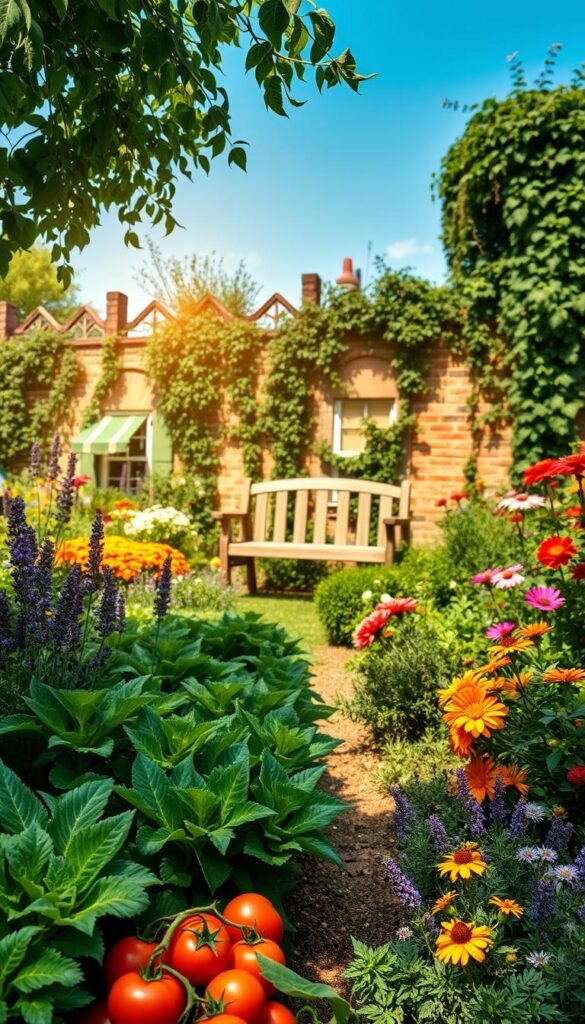
Growing a lot in a little space starts with rethinking how you use every inch. Successful small garden owners know fertile soil matters most—raised beds can triple yields compared to traditional rows. “Feed the earth first, and it’ll feed you better,” says urban grower Maria Krontiri.
Your mindset determines your harvest. Instead of wishing for more room, focus on what thrives in your conditions. Many gardening disappointments happen when big-farm methods meet compact areas. Adapt techniques to your unique plot.
Why do some spaces flourish while others fail? Intensive care beats sheer size. Choose plants that work harder—like bush beans instead of pole varieties. Rotate crops faster by planting radishes between slow-growing kale.
Treat your vegetable garden like a puzzle. Each piece—sun patterns, watering access, plant friendships—fits together perfectly. You’ll discover clever ways to stretch seasons and protect crops naturally.
This foundation helps you avoid common mistakes. Whether you want to grow herbs on a balcony or veggies in a courtyard, smart choices turn limits into lush results. Your journey begins with seeing potential where others see problems.
Designing Your Space for Maximum Yield
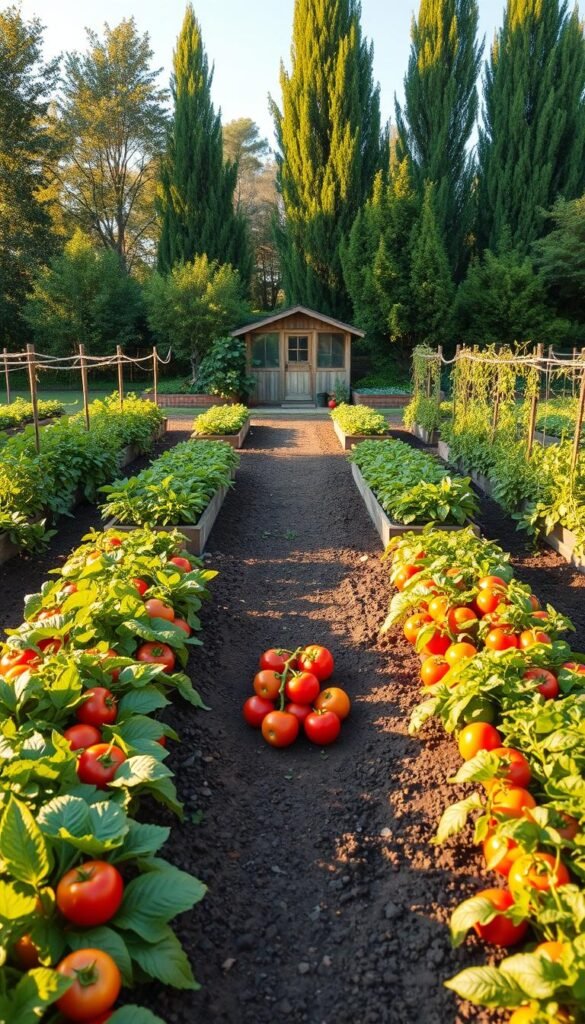
Your edible paradise begins with three key elements most beginners ignore: light patterns, earth quality, and smart placement. Let’s turn your patch into a powerhouse.
Assessing Sunlight, Soil, and Space
Track where shadows fall every 2 hours using free apps like Sun Surveyor. Leafy greens tolerate partial shade, but tomatoes demand 8+ hours of direct sun. Test your soil with a $7 kit from hardware stores—aim for 6.0-7.0 pH for most vegetables.
Check drainage by digging a 12-inch hole. If water remains after 4 hours, mix in compost or build raised beds. Tight on space? Try a square-foot garden strategy that crams 16 crops into 4×4 feet.
Planning the Layout with a Vision
Sketch beds on graph paper, marking mature plant widths. Bush zucchini needs 3 feet, while carrots thrive in 6-inch rows. Leave 18-inch paths between beds—you’ll thank yourself during harvest.
Group thirsty plants like cucumbers near water sources. Position tall crops (beans, corn) northside to avoid shading others. Rotate vegetable families yearly to prevent soil depletion. Your garden layout becomes a living blueprint that evolves with each season’s lessons.
Embracing Raised Beds and Container Ideas
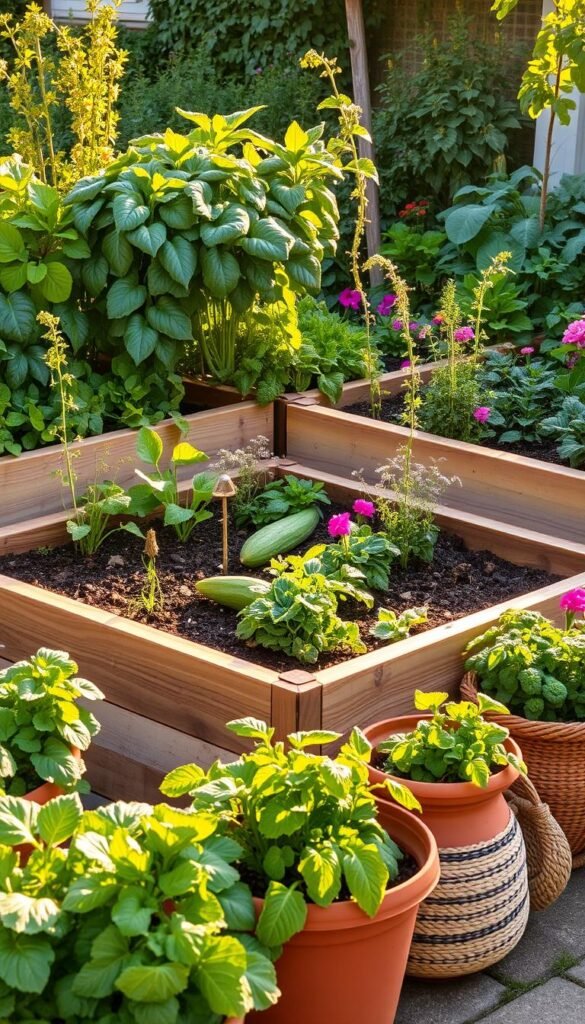
Growing more in tight quarters becomes easier when you work with your space instead of against it. Raised beds and containers turn challenging areas into productive zones. They adapt to your needs while boosting plant health.
Why Raised Beds Deliver Big Results
Raised beds outperform ground planting by giving you command over soil quality. You eliminate compaction issues and improve drainage instantly. Studies show these beds yield 4x more per square foot than traditional rows.
Custom soil mixes prevent nutrient deficiencies. A 50/30/20 blend of compost, topsoil, and perlite works for most vegetables. For those starting out, building a raised bed takes under two hours with basic tools.
Containers: Grow Anywhere, Anytime
No yard? No problem. Containers thrive on patios, fire escapes, or windowsills. Self-watering pots reduce daily chores—perfect for busy growers. Try these space-smart options:
| Feature | Raised Beds | Containers |
|---|---|---|
| Cost | $50-$200 | $10-$75 |
| Mobility | Fixed location | Portable |
| Best For | Root crops, leafy greens | Herbs, cherry tomatoes |
Group pots on wheeled carts to chase sunlight. Use vertical planters for strawberries or salad greens. With containers, your gardening possibilities stretch as far as your imagination.
Smart Veggie Garden Layout Tips for Maximizing Small Plots
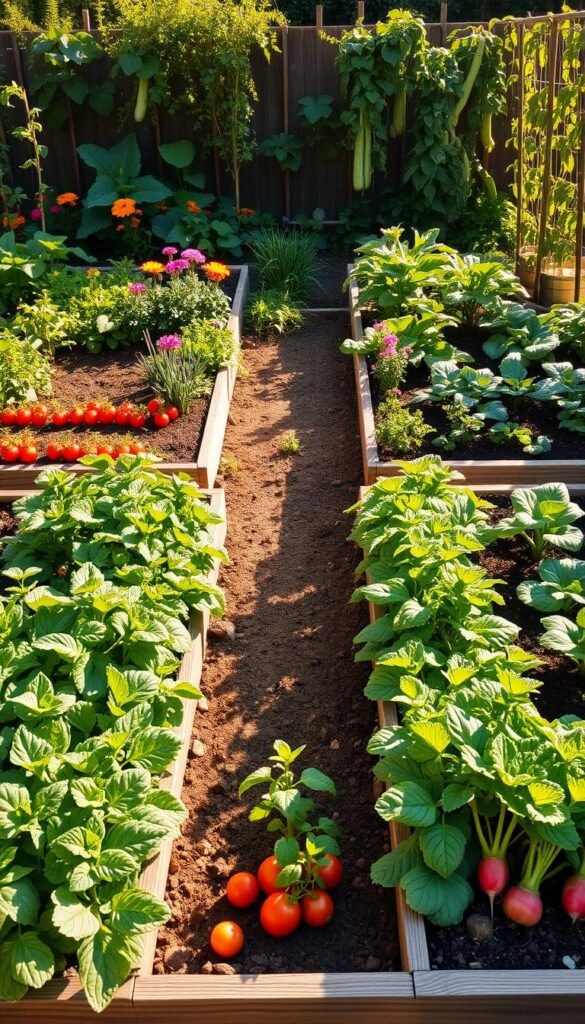
Transform your limited growing area into a powerhouse of productivity with strategic planting arrangements. Steven Biggs emphasizes that switching from rows to clustered blocks lets you grow twice as many vegetables in the same footprint. This method reduces bare soil while creating a lush, efficient vegetable garden layout.
Block-style planting groups crops in geometric patterns rather than single-file lines. Compare these approaches:
| Feature | Block Style | Traditional Rows |
|---|---|---|
| Plants per sq ft | 8-12 | 3-5 |
| Harvest Frequency | Every 2-3 weeks | Seasonal |
| Maintenance Ease | High (grouped care) | Low (spread out) |
Pair fast-growing radishes with slow-maturing carrots—they’ll share space without competing. When the radishes finish, carrots claim the full area. This interplanting strategy keeps your garden layout productive year-round.
Calculate spacing using seed packet recommendations, then reduce distances by 25% for block setups. Leave 12-inch access paths between planting zones to avoid soil compaction. Succession planting becomes simple: as one crop finishes, another takes its place.
Choose compact vegetable varieties bred for small space performance. Dwarf tomatoes and bush beans thrive in tight quarters while delivering full-sized flavors. Your plot’s potential grows when every inch works smarter, not harder.
Vertical Gardening Techniques to Expand Your Space
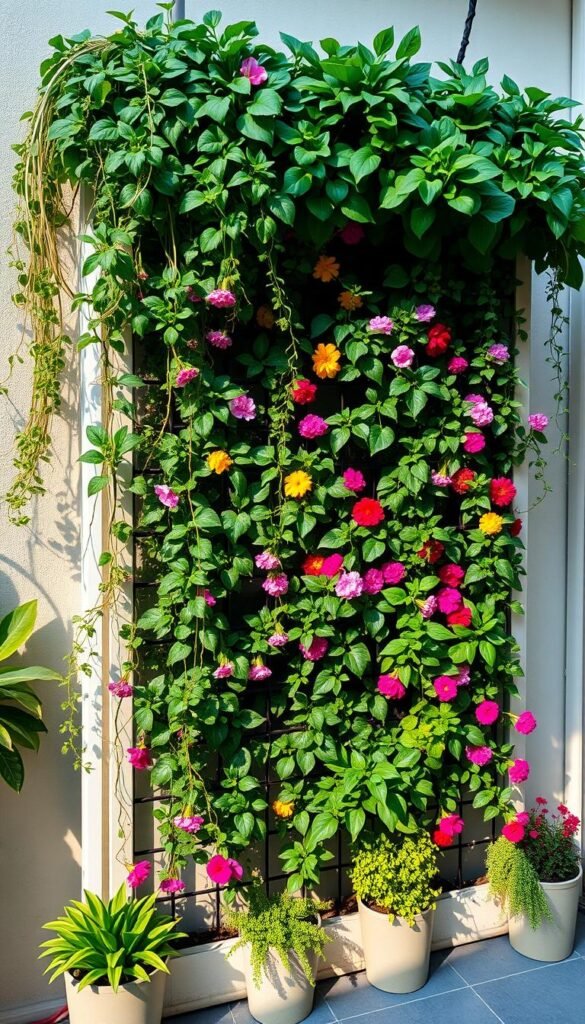
Elevate your harvest potential by growing upwards instead of outwards—vertical systems turn walls and fences into edible landscapes. These methods let you cultivate twice as many crops without expanding your plot’s footprint.
Utilizing Trellises for Climbing Crops
Train pole beans and snap peas to climb bamboo stakes or wire grids. A sturdy trellis supports vining plants while freeing ground space for shade-tolerant greens. Try these pairings:
- Malabar spinach + leaf lettuce
- Cucumbers + arugula
- Runner beans + mint
Metal cattle panels make durable arches for heavy squashes. Position them north-south to prevent shading other plants.
Innovative A-Frame and Hanging Basket Ideas
Build a portable A-frame from bamboo and chicken wire. Grow cucumbers up the sides while planting cilantro underneath—the structure provides afternoon shade for delicate herbs. Compare space-saving options:
| Structure | Best Crops | Cost |
|---|---|---|
| A-Frame | Cucumbers, bitter melon | $25-$50 |
| Hanging Baskets | Strawberries, cherry tomatoes | $8-$20 |
Suspend fabric planters from pergolas for trailing beans or dwarf peas. Refresh soil annually and rotate crops to maintain plant health. With these ideas, your vertical garden becomes a layered paradise of flavors.
Planting Densely: Maximizing Your Crop Potential
Unlock hidden potential in your plot by reimagining how seeds meet soil. Seed packets often suggest wasteful spacing for commercial equipment—not your space-saving goals. Try this: scatter seeds in blocks instead of straight rows, then thin plants gradually as they grow.
Leafy greens and root crops like carrots thrive when crowded. Start by sowing twice as many seeds as recommended. As seedlings emerge, harvest every other plant as microgreens. You’ll enjoy early yields while giving survivors room to mature.
| Crop | Packet Spacing | Dense Spacing | Thinning Harvest |
|---|---|---|---|
| Beets | 3″ apart | 1.5″ apart | Baby greens at 2 weeks |
| Carrots | 2″ apart | 1″ apart | Baby carrots at 30 days |
| Lettuce | 12″ apart | 6″ apart | Outer leaves weekly |
Rich soil fuels dense planting. Boost nutrition with compost before sowing. In warm climates like Zone 9, reduce spacing by 25%—plants grow faster but compete less in heat.
Watch for these signs of perfect density:
- Leaves barely touch at maturity
- No visible soil between plants
- Easy access for watering
Experiment with varieties bred for tight quarters. Parisian carrots and Little Gem lettuce pack flavor into compact forms. Your plants will prove crowded can be productive!
Companion Planting and Crop Selection Strategies
What if your plants could work together like best friends at summer camp? Strategic pairings let crops share resources while outsmarting pests. Steven Biggs’ radish-carrot combo shows how fast growers can prep the stage for slower vegetables—harvesting one crop literally paves the way for another.
Time Your Harvests Like a Pro
Scatter radish seeds among carrots or beets. The peppery roots mature in 30 days, loosening soil for their slower neighbors. When you pull them, carrot seedlings gain instant breathing room. Try these dynamic duos:
| Quick Crop | Slow Partner | Bonus Benefit |
|---|---|---|
| Spinach | Peppers | Shade for young pepper plants |
| Bush beans | Corn | Beans fix nitrogen corn craves |
Natural Pest Control Partnerships
Some plants emit scents that confuse hungry insects. Onions disguise carrots from root flies, while basil’s aroma repels aphids attacking tomatoes. For container setups, pair beans and tomatoes—their root depths complement each other perfectly.
Marigolds aren’t just pretty. French varieties release a chemical that deters nematodes. Plant them near crops like potatoes or strawberries for underground protection. Your companion planting choices become a living pest-control system.
Rotate plant families yearly to break disease cycles. Follow nitrogen-hungry corn with soil-enriching peas. With smart pairings, your plot becomes a thriving community where every plant plays multiple roles.
Optimizing Soil Fertility and Garden Maintenance
Healthy soil acts like a savings account for your plants—deposit organic matter now for bigger harvests later. Unlike synthetic fertilizers that offer quick fixes, natural amendments feed the underground workforce of microbes and earthworms. “Test first, then invest,” advises urban farmer Lila Nguyen. “Your soil’s needs change like your grocery list.”
Organic Amendments and Soil Testing
Start with a $15 soil test kit to uncover hidden deficiencies. Ideal soil for most crops has:
- 6.0-7.0 pH level
- 4-5% organic matter
- Balanced nitrogen-phosphorus-potassium ratios
Mix amendments based on your garden‘s specific needs:
| Amendment | Best For | Application Rate |
|---|---|---|
| Compost | All beds | 2-inch layer yearly |
| Worm castings | Container plants | 1 cup per sq ft |
| Leaf mold | Acid-loving crops | 3-inch mulch layer |
Rotate heavy feeders like tomatoes with nitrogen-fixing peas. In raised beds, refresh the top 6 inches each spring with compost-enriched mix. Your root vegetables will reward you with crisp textures and vibrant colors.
Establish a composting routine using kitchen scraps and fallen leaves. Turn the pile weekly to speed decomposition—you’ll create black gold that boosts water retention and disease resistance. Healthy soil means fewer pests and tastier harvests!
Creative Pathways and Garden Bed Designs
Your pathways hold untapped potential—they’re the hidden hero of your growing space. By rethinking their shape and placement, you’ll carve out more room for plants without sacrificing access. Start by sketching your garden bed layout with narrow walkways that bend or taper into dead ends, like the efficient keyhole garden design that saves ground area.
Instead of straight paths cutting through beds, create U-shaped routes that reach halfway into larger planting zones. This way of planning lets you tend crops from multiple angles while using less space for foot traffic. Pair this with raised beds built using budget-friendly materials to maximize every inch.
Keep main pathways 18-24 inches wide for wheelbarrows, but shrink secondary routes to 12 inches where possible. Use gravel or repurposed bricks for durable surfaces that suppress weeds. For tight corners, try triangular garden bed shapes that eliminate wasted space between plants.
Your best ideas will blend practicality with creativity. Curve pathways around clusters of herbs, or build stepping stones through leafy greens. With smart layout choices, you’ll grow more food while keeping your beds within easy reach—proving that clever design truly paves the way to abundance.

